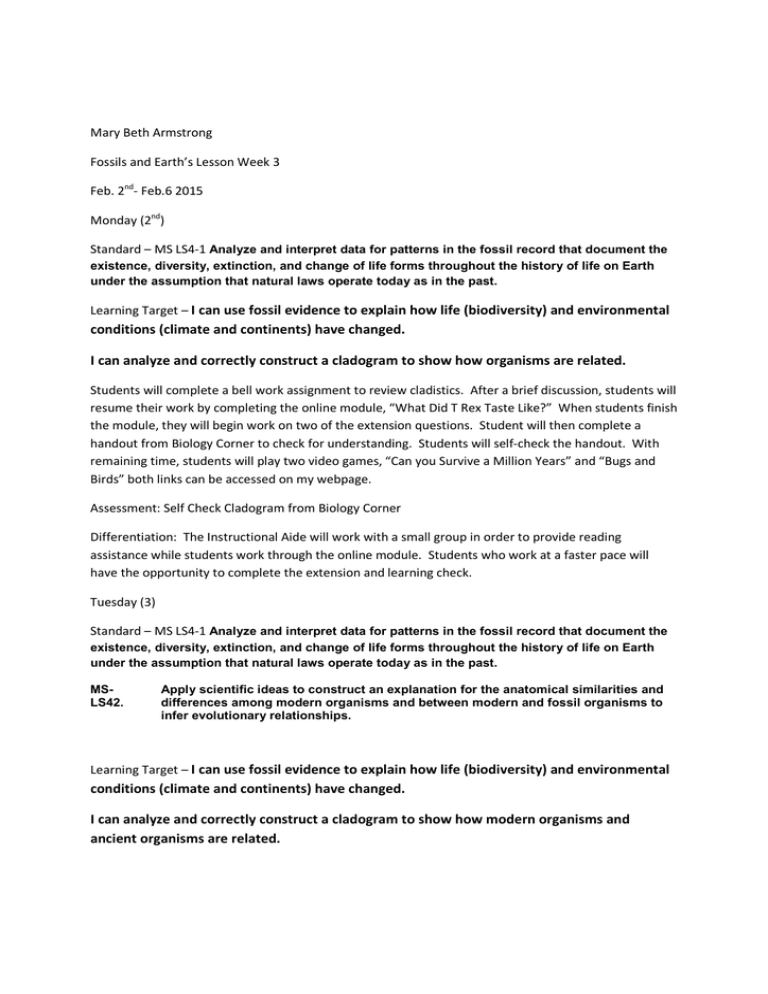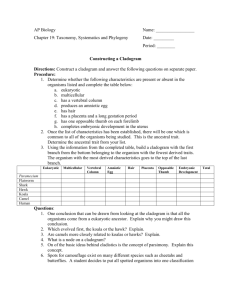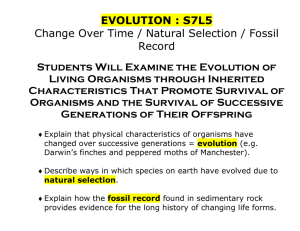Mary Beth Armstrong Fossils and Earth’s Lesson Week 3 Feb. 2
advertisement

Mary Beth Armstrong Fossils and Earth’s Lesson Week 3 Feb. 2nd- Feb.6 2015 Monday (2nd) Standard – MS LS4-1 Analyze and interpret data for patterns in the fossil record that document the existence, diversity, extinction, and change of life forms throughout the history of life on Earth under the assumption that natural laws operate today as in the past. Learning Target – I can use fossil evidence to explain how life (biodiversity) and environmental conditions (climate and continents) have changed. I can analyze and correctly construct a cladogram to show how organisms are related. Students will complete a bell work assignment to review cladistics. After a brief discussion, students will resume their work by completing the online module, “What Did T Rex Taste Like?” When students finish the module, they will begin work on two of the extension questions. Student will then complete a handout from Biology Corner to check for understanding. Students will self-check the handout. With remaining time, students will play two video games, “Can you Survive a Million Years” and “Bugs and Birds” both links can be accessed on my webpage. Assessment: Self Check Cladogram from Biology Corner Differentiation: The Instructional Aide will work with a small group in order to provide reading assistance while students work through the online module. Students who work at a faster pace will have the opportunity to complete the extension and learning check. Tuesday (3) Standard – MS LS4-1 Analyze and interpret data for patterns in the fossil record that document the existence, diversity, extinction, and change of life forms throughout the history of life on Earth under the assumption that natural laws operate today as in the past. MSLS42. Apply scientific ideas to construct an explanation for the anatomical similarities and differences among modern organisms and between modern and fossil organisms to infer evolutionary relationships. Learning Target – I can use fossil evidence to explain how life (biodiversity) and environmental conditions (climate and continents) have changed. I can analyze and correctly construct a cladogram to show how modern organisms and ancient organisms are related. Students will work with an elbow partner to complete a trait chart. Students may use their phones to research the various organisms. Students will then be given a cladogram outline which they must fill in. Pairs will be given 13-15 minutes to work. Then students will compare ideas across the table. Groups will try to reach a consensus on their cladograms. If time remains, group volunteers will share their cladograms under the document camera with the class. The class will compare their cladograms and will make comments about what they agree with and what they might want to change. Assessment – comparison of student cladograms to their table group Differentiation – partner and group work, talk Wednesday (4) MSLS42. Apply scientific ideas to construct an explanation for the anatomical similarities and differences among modern organisms and between modern and fossil organisms to infer evolutionary relationships. I can analyze and correctly construct a cladogram to show how modern organisms and ancient organisms are related. To finish up Tuesday’s activity, students will compare their cladograms and will make comments about what they agree with and what they might want to change. Class discussion will continue until students are satisfied that they have the correct answers. If students have something wrong, I will use questioning to make sure that students find the error. Students will then use the remainder of the class period to begin work on a performance task in which students must apply what they have learned to a new cladogram. Assessment – performance task Thursday (6) Standard – MS LS4-1 Analyze and interpret data for patterns in the fossil record that document the existence, diversity, extinction, and change of life forms throughout the history of life on Earth under the assumption that natural laws operate today as in the past. Learning Target – I can carry out an investigation on Natural Selection to see if insect color affects future populations of insects. Students will begin class with a quick discussion/meeting with their elbow partners and their cladogram answers. Different groups will present their cladogram on the SMART Board and classmates will offer feedback for the pairs. This will continue until students convince other students that their answers make sense and are correct. Students will then work in small groups to conduct an investigation. Each group will have 10 beans of 5 different colors and a piece of fabric containing a natural pattern. Two of the students in the group will strategically place the beans on the fabric while the third group member covers his/her eyes. Upon uncovering his eyes, the student will pick up the first ten beans they see. Students will play four rounds and will keep track of numbers of beans removed with each round. Students will see how the organisms with the genes for certain colors will thrive while the colors picked off by the birds will dwindle. Students will try at least two different types of fabric to see how different environments influence insect populations. Assessment: How would you explain natural selection to a 7th grader using the bug/bird model we used in class? Differentiation: Small groups will be heterogeneous. Friday (6) Smithsonian Leaf Margin Analysis MS ESS 4-1: Construct a scientific explanation based on evidence from rock strata for how the geologic time scale is used to organize Earth’s 4.6 billion year old history. LT-4 I can use fossil evidence to explain how life (biodiversity) and environmental conditions (climate and continents) have changed. Students will: • • • • • Complete a bell work assignment to review LT 1-3. Work with a partner to sort pictures (from two locations) of leaf fossils into smooth edged and toothed edged. Complete a data table for the leaf data. Students will use a mathematical formula to determine the percent of smoothed edged leaves vs. toothed leaves at each location. This formula will then be used to calculate the climate for each location. Next, students must convert the temperatures from degrees C to degrees F. Finally, students will analyze a graph in order to determine the cause of the climate change illustrated by the leaf data. Formative Assessment: Leaf Activity, Exit Slip Differentiation: Grouping with partner if extra assistance is needed.






